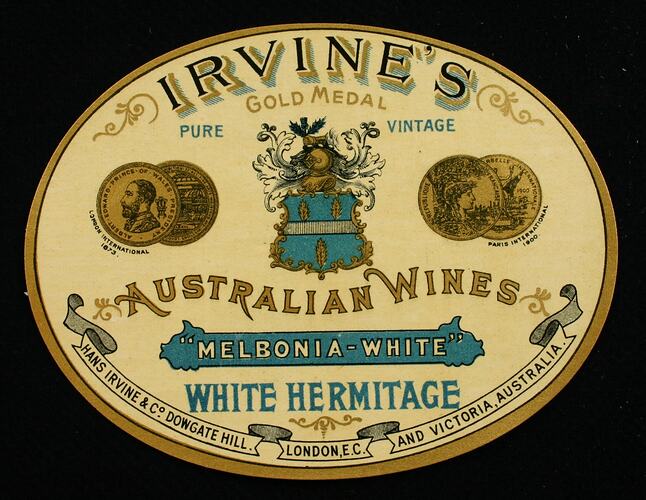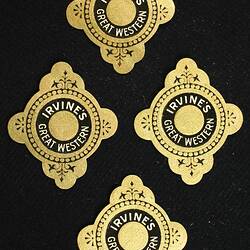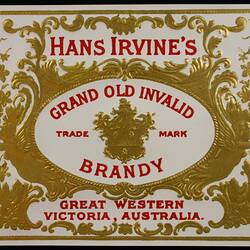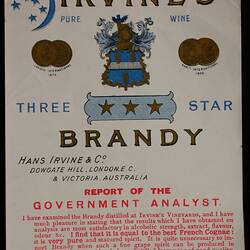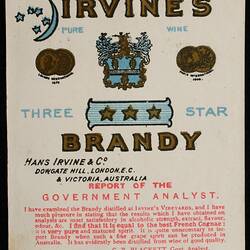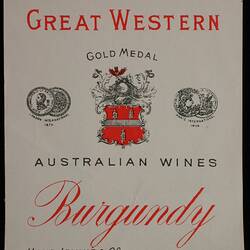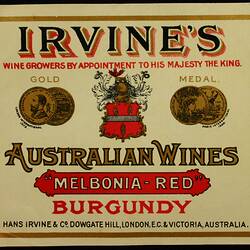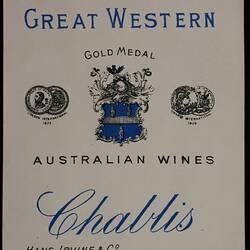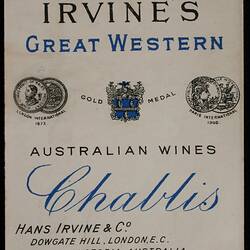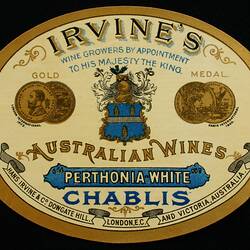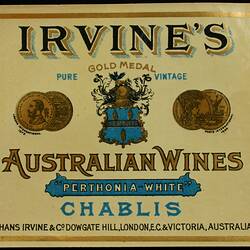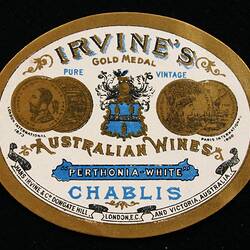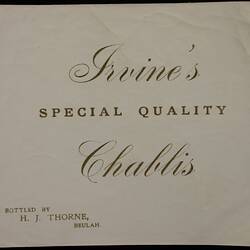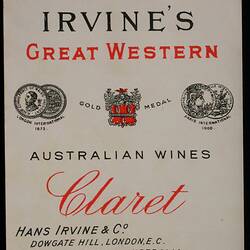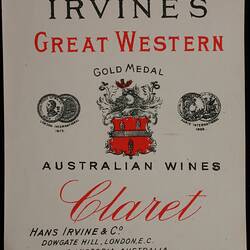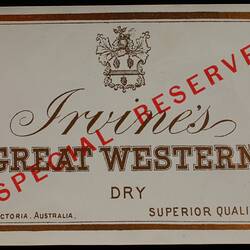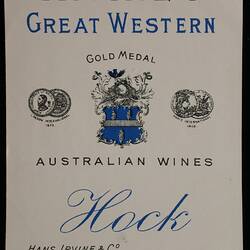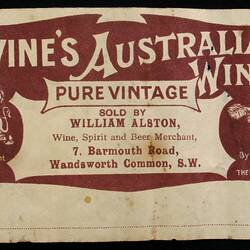The Great Western wine labels in Museums Victoria's collection are mostly later examples of proprietor Hans William Henry Irvine's advertising, most being post 1905; a few are post 1908. The time period of the wine labels is determined by the details of the label text. Any label that depicts the two prize medals, from the London International of 1873 and the Paris International of 1900, is post 1900. It must be noted Irvine did not actually win the 1873 medal for his wines, as he did not take possession of the vineyard until 1888 [1]. This prize was won by Joseph Best's wines; and its inclusion on the majority of Irvine's labels is indicative of Irvine's desire to establish a continuum of quality wine-making at Great Western. Post 1905 labels are those that have the address of Irvine's London depot, as this is when it opened [2]. While any labels with the wording 'By appointment to His Majesty the King' are post 1908, as this is when Irvine was granted this privilege, and there were very stringent laws regarding the use of this phrase [3].
At the Great Western Vineyard, currently owned by Seppelt, they carry a surviving example of one of the bottles of claret produced by Hans Irvine, dated 1898. The label on the bottle was printed by McCarron Bird & Co., Melbourne, and is quite different to the majority of the Museum's collection [4]. The older labels held by Museum Victoria are less colourful, often only utilising one shade of ink, rectangular rather than round, more sedate, and display four medals rather then the later two (London International 1873, Melbourne International 1875 and 1888, and Bordeaux International 1882). The latest medal on these older labels is the International Wine Exhibition Grand Champion Prize of Australia in 1893, making these as late 19th century examples. These older labels still display the Irvine crest and the text 'Great Western Vineyard, Victoria, Australia.'
The 'newer labels' may have been designed by a professional draftsman; the Irvine Collection held by the State Library of Victoria contains a few examples of pencil sketches of the label designs [5]. The design remained essentially the same, but the artist fiddled with the amount of medals displayed (anywhere from 8 to 2), the placement of text and the arrangement of the medals. All the labels display the Irvine family crest, which depicts an armoured helmet atop a shield with three holly leaves - a crest derived from the Irish Irvine family shield. The text of the crest reads 'Dom memor ipse mei', which is a line from Virgil's Aeneid in translation reads: "As long as I have memory of myself" [6]
The colours used on the new labels reflect the strong colour scheme Irvine utilised on his pressed metal advertising signs, which were usually blue or red, with yellow or white writing. The multiplicity of colours suggests the labels were most likely printed using a technique called chromolithography, a popular method of mass printing in the 19th century and one which Irvine would have been very familiar with [7]. All of the Hermitage labels in the Museums' collection are post-1905, and correspond to the establishment of his London office where Irvine was trying to market his Australian wines in England. The design of the labels reflects his desire to highlight the heritage of his wines. The words 'Australian Wines' are the most prominent feature of the labels, often in gold lettering, as well as the name of the wine itself, which was given the namesake of an Australian capital city (eg., Perthonia White, Melbonia Red). Irvine would have known a fair amount about printing and lettering, having worked as a lithographer for most of his early life. Along with the bright colouring, the red, blues and whites perhaps reflect the colours of the English flag, as a way to gain the attention of British customers.
The Claret and Brandy labels were found on tall, cylinder shaped bottles; the brandy bottle was brown, whilst the claret bottle was green. Most of the tall bottle labels had matching small kidney shaped, neck labels. All the Burgandies and Hermitage labels were attached to squat, oval shaped brown bottles, which had no neck labels, but did have foil around the cork. The colour of the foil depended on the wine type; Melbonia Red was red with 2 gold bands, Melbonia White was silver bronze with 2 gold bands, Perthonia Red was red with two green bands, Perthonia White was gold with two red bands, Shirazo was blue with two red bands and the Brandy had a neck label and opal white foil with 2 gold and 1 red bands [8].
References:
[1] Ballarat Star, 9 May 1888.
[2] State Library of Victoria, Irvine Manuscript Collection, box 3523/3.
[3] Letter between Alfred Watson and the secretary of Sir William Carrington, September 7th, 1908. State Library of Victoria, Irvine Manuscript Collection, box 1567/4
[4] Irvine had connections with the printing company F.W Niven & Co., so it is possible the labels were printed by them. Some of his receipt books contain references to the company. However, surviving examples of their work tend to be booklets and pamphlets, not wine labels. (State Library of Victoria, Australian Manuscript Collection, Business Records Accession number: MS 11853)
[5] State Library of Victoria, Irvine Manuscript Collection, 1567/4
[6] University of Queensland notes on The Aeneid, accessed at 3.43pm on 25 January 2009 http://www.uq.edu.au/hprcflex/lt1240/aencom3.htm
[7] Irvine was a apprentice lithographer with the Ballerat firm Niven & Co. before he purchased Great Western (Ballerat Star, 30 April 1888, The Australian Traveller, 7 October 7 1905). Wytt Morro interview conducted for the 'Sip in Time' exhibition, 1994 (TRIM file CM/087/00032)
[8] State Library of Victoria, Irvine Manuscript Collection, box 1565/2
More Information
-
Keywords
-
Authors
-
Article types
